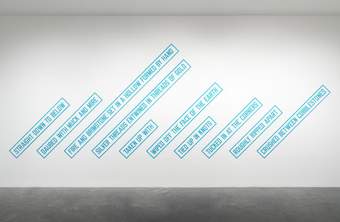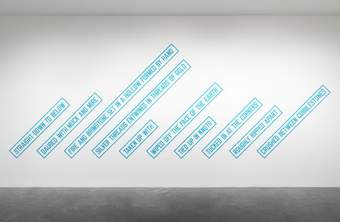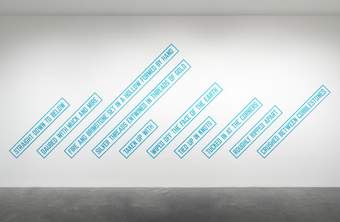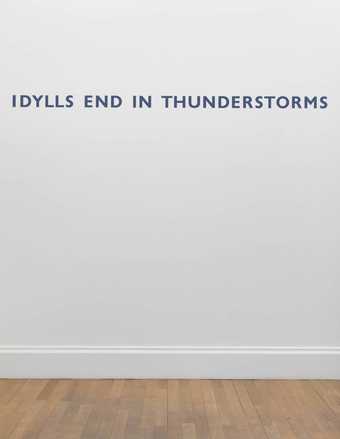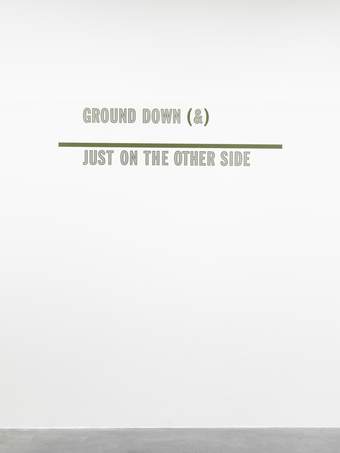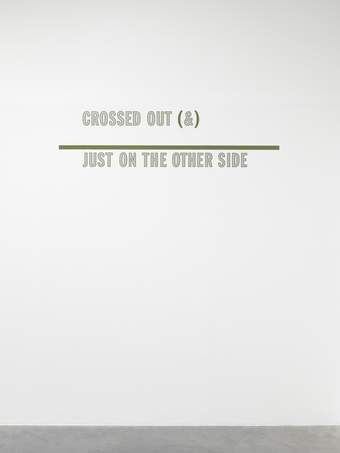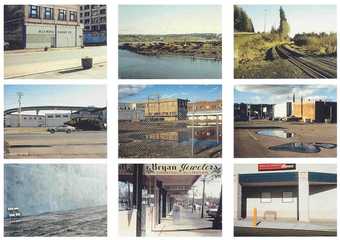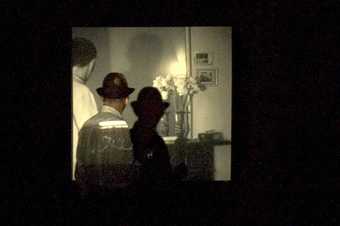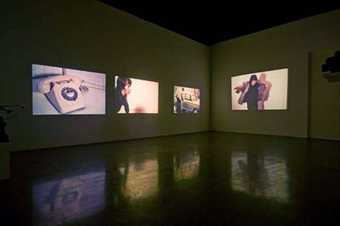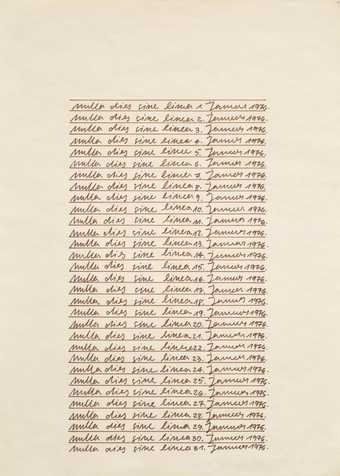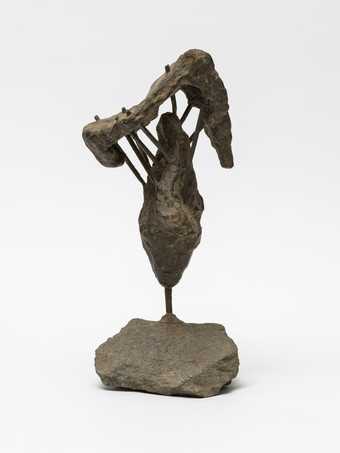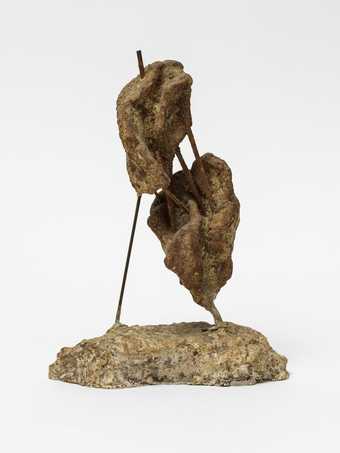Not on display
- Artist
- Marina Abramovic born 1946
- Medium
- Table with 72 objects and slide projector with slides of performance and text
- Dimensions
- Overall display dimensions variable
- Collection
- Tate
- Acquisition
- Presented by the Tate Americas Foundation 2017
- Reference
- T14875
Summary
Rhythm 0 by the Serbian artist Marina Abramovic comprises seventy-two objects set out on a long table covered with a white tablecloth, as well as sixty-nine slides. The slides are projected onto the gallery wall above the table from a projector which sits on a stand. Among the objects on the table is a framed description of a performance piece of the same name that took place at Studio Morra in Naples in 1974. The slides document this performance and the objects replicate the original props used. Many are perishable items, such as foodstuffs and flowers, which need to be replaced each time the work is displayed. The work was remade for exhibition purposes in 2009 as part of the Abramovic’s retrospective exhibition at the Museum of Modern Art, New York. It exists in an edition of three plus two artist’s proofs, and Tate’s copy is number one in the edition.
The list of props in the work is as follows:
gun
bullet
blue paint
comb
bell
whip
lipstick
pocket knife
fork
perfume
spoon
cotton
flowers
matches
rose
candle
mirror
drinking glass
polaroid camera
feather
chains
nails
needle
safety pin
hairpin
brush
bandage
red paint
white paint
scissors
pen
book
sheet of white paper
kitchen knife
hammer
saw
piece of wood
ax
stick
bone of lamb
newspaper
bread
wine
honey
salt
sugar
soap
cake
metal spear
box of razor blades
dish
flute
Band Aid
alcohol
medal
coat
shoes
chair
leather strings
yarn
wire
sulphur
grapes
olive oil
water
hat
metal pipe
rosemary branch
scarf
handkerchief
scalpel
apple
Abramovic’s original intention for the piece is explained by her written instructions which accompanied the work:
Instructions.
There are 72 objects on the table that one can use on me as desired.
Performance
I am the object.
During this period I take full responsibility.
1974
Duration: 6 hours (8pm–2am.)
Studio Morra, Naples
(Reproduced in Biesenbach 2009, p.74.)
Thus, for a period of six hours, visitors were invited to use any of the objects on the table on the artist, who subjected herself to their treatment. The artist has stated, ‘the experience I drew from this work was that in your own performances you can go very far, but if you leave decisions to the public, you can be killed’ (quoted in Ward 2009, p.132). It is important to note that for the purpose of museum display, the gun has been deactivated and, together with other dangerous items, secured to the table. It is not the artist’s intention that the performance should be repeated. Instead, while many performance works rely on photographic or video documentation only, this work physically incorporates the ‘instruments’ used as props in the performance (or their replicas), so that the mechanics of threat and seduction played out in the original work are palpable to the viewer, especially when seen in combination with the slides documenting the event.
As with many of Abramovic’s works, themes surrounding the physicality of the body, endurance, pain and the staging of authentic live actions are dealt with in an experimental way, incurring a degree of personal risk and suffering. The objects that could be ‘used on her’ were chosen to represent both pain and pleasure. Through the risk to her own person in this work, and her acceptance of that risk, Abramovic also explored collective action and responsibility. The ritualistic and quasi-sacred character of the table-as-altarpiece is a common theme in Abramovic’s work, as is her own performative contribution. Her role as shaman-like figure was played out in her performance for her 2009 retrospective at the Museum of Modern Art: entitled The Artist is Present, it involved her sitting in a meditative state and staring into the eyes of one visitor at a time throughout the duration of the show.
Rhythm 0 is one of Abramovic’s most important works. It was the last work in a series of individual body art performance pieces that began with Rhythm 10, and according to the artist it presents ‘the conclusions of my research on the body when conscious and unconscious’ (Abramovic in Biesenbach 2009, p.74). For example, in Rhythm 10 Abramovic used a collection of twenty knives to stab repeatedly at a piece of paper between her fingers. Each time she cut herself she changed knives, until she had used all the knives. This series was made just prior to the important sequence of works Abramovic created in collaboration with the artist Ulay (Frank Uwe Laysiepen).
Further reading
RoseLee Goldberg, Performance Art: From Futurism to the Present, London 1999, p.165.
Frazer Ward, ‘Marina Abramovic: Approaching Zero’, in Anna Dezeuze (ed.), The ‘Do-it-Yourself’ Artwork: Participation from Fluxus to New Media, Manchester 2009, pp.132–44.
Klaus Biesenbach (ed.), Marina Abramovic: The Artist is Present, exhibition catalogue, Museum of Modern Art, New York 2009.
Catherine Wood
March 2010
Does this text contain inaccurate information or language that you feel we should improve or change? We would like to hear from you.
You might like
-
Lawrence Weiner FIRE AND BRIMSTONE SET IN A HOLLOW FORMED BY HAND
1988 -
Lawrence Weiner SILVER THREADS ENTWINED IN THREADS OF GOLD
1988 -
Lawrence Weiner ROUGHLY RIPPED APART
1988 -
Lawrence Weiner CRUSHED BETWEEN COBBLESTONES
1988 -
Ian Hamilton Finlay IDYLLS END IN THUNDERSTORMS
1986 -
Robert Smithson Ithaca Mirror Trail, Ithaca, New York
1969 -
Lawrence Weiner GROUND DOWN (&) JUST ON THE OTHER SIDE
1990 -
Lawrence Weiner CROSSED OUT (&) JUST ON THE OTHER SIDE
1990 -
Rodney Graham Aberdeen
2000 -
Marc Camille Chaimowicz Partial Eclipse...
1980–2006 -
David Lamelas Film Script (Manipulation of Meaning)
1972 -
Rasa Todosijevic Nulla dies sine linea
1976 -
Olga Jevric Inhabited Void
1966 -
Olga Jevric Vertical Composition
1956–9 -
Olga Jevric Complementary Form II
1963



